Click image for BBB rating
See our Privacy Policy
cool="cool" width="785" height="11493" border="0" cellpadding="0" cellspacing="0" gridx="16" showgridx="showgridx" usegridx="usegridx" gridy="16" showgridy="showgridy" usegridy="usegridy" bgcolor="#99ccff">
|
|
|
 |
|
|
|
|
|
Welcome to Spaightwood Galleries, Inc.
120 Main Street, Upton MA 01568-6193
You can follow us on Facebook at http://www.facebook.com/pages/Spaightwood-Galleries-Inc/122951564441757
I blog there regularly and announce special events and special sales.
|
|
|
|
|
|
This show was born in a discussion about a passage in Sir Philip Sidney's Old Arcadia (1579-80), in which the narrator describes the virtuous and virginal heroine as wearing a dress "so near nakedness that one might well discern part of her perfections, and yet so apparelled as did show that she kept the best store of her beauties to herself; her excellent fair hair drawn up into a net made only of itself (a net indeed to have caught the wildest disposition); her body covered in a light taffeta garment so cut as the wrought smock came through it in many places (enough to have made a very restrained imagination to have thought about what was under it)." One of the thoughts this passage inspired was that essentially women were a mystery to men—including artists: creatures able to tame the wildest and make wild the tamest, perhaps simultaneously! We began to wonder about the traditional disjunctive classification of women as either saints or sluts, a distinction reified in a 1990 show at The National Gallery of Art, Eva / Ave: Women in Renaissance and Baroque Prints by H. Diane Russell. In the passage quoted above from The Old Arcadia, it is not women but the imaginations of men that seem to be the issue. The same situation seems often the case in Renaissance prints and drawings as well. When we see a Susanna or a Bathsheba innocently bathing, a violated Lucrece, or a penitent Mary Magdalene, the mind registers one understanding of the scene even as the imagination is invited to create another. Thus was born a curiosity about the depictions of women in a wide variety of sixteenth and seventeenth-century prints and drawings presenting women in the contexts of biblical history, secular history, mythology, "real life," and life moralized.
The story of Judith and Holofernes can be found in apocryphal Book of Judith, which tells of the wrath of Nebuchadnezzar, King of Assyria. Having decided to wage war against the Medes, he calls for all the peoples of the West to aid him in his conquest and is enraged when they refuse. After he defeats the Medes, he vows a war of conquest and slaughter against all who refused to join him in his war and appoints his general, Holofernes, to lead an army against them so that they might learn that there is no god on earth but Nebuchadnezzar. The Jews resist and Holofernes starts a campaign to let thist and hunger drive them into submission. The people pray to the Lord for aid, but when he does not immediately act, they come to their ruler and demand that he surrender so that they don't have to watch their children die of thirst. Judith, a rich and beautiful widow from the town of Bethulia, invites the the elders to visit her. Rebuking them for trying to force God to act by their timetable, she promises to pray that God accept her as a means to destroy the Assyrian army. She takes off her widow's weeds of sackcloth, washes and annoints herself with oil, puts on her finest clothes, and she and her maid go to confront Holofernes, telling him that God has turned against the people and that she will go out behind the camp every night and pray that the Lord make her the means to let Holofernes know when to begin his battle. Amazed by her beauty and her wisdom, Holofernes invites her to his tent to eat with him, she agrees t come, but not to eat, lest it be an occasion of sin. Putting on her "festive garments and all her feminine adornments, she reclines in front of Holofernes, who is filled with desire at the sight of her: "The heart of Holofernes was in rapture over her and his spirit was shaken, He was burning with desire to possess her, for he had been biding his time to seduce her since the first day he saw her" (Judith 12: 15-17). She drinks a little, but he drinks "more than he had ever drunk on one single day in his life" and passes out on the bed. Taking his sword, she prays to God for strength and cuts off his head with his own sword. She and her servant load the head into the bag in which she had kept her food when she went out nightly to pray and departs. The next day the pople of Bethulia hand Holofernes' head upon the walls of the city and prepare for battle. The Assyrians rush to wake Holofernes, discover his headless body, and lament: "A single Hebrew woman has brought disgrace upon the house of King Nebuchadnezzar" and shows them Holofernes' headless body upon the ground. The Assyrian army is "seized with consternation," panics, and flees, while the Isrealites warriors overcome them (Judith 14:18-15:4). After victory is complete, Judith leads "all Israel in a song of thanksgiving (Judith 16:1-17), dedicates on an altar in Jerusalem as a votive offering to God, then retires to her estate where she lives until her death at the age of 105 years old."
|
|
|
|
|
|
|
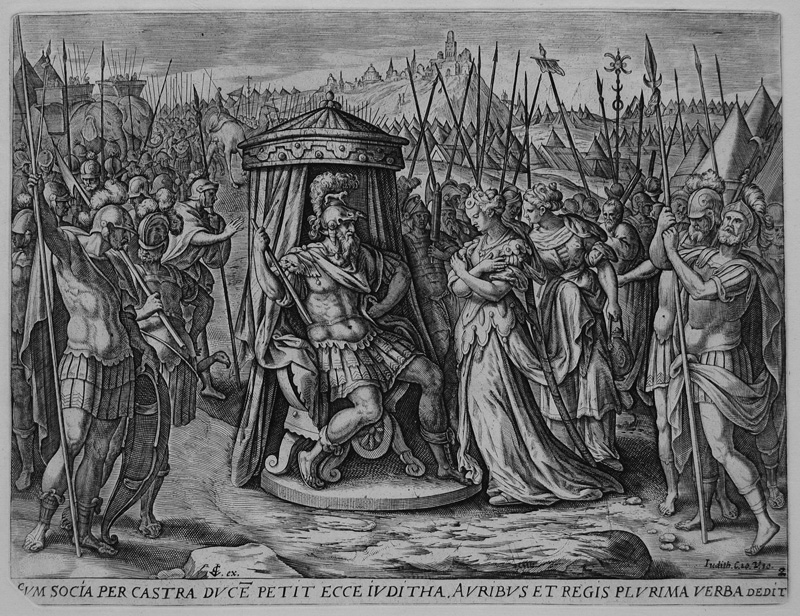 |
|
|
|
Maarten de Vos (Dutch, 1531-1603), after, Judith presented to Holofernes (New Holl. 173 iii/iii). Original engraving after a drawing by de Vos. , c. 1585. From the Story of Judith (4 plates first published thus in 1585). A rich impression on laid paper with the addition of "Iudith c.10.v.10" bottom right and the addition of the number "2" in the corner far right and after the corner of the plate broke off before the printing of the 1639 edition of the Theatrum Biblicum republished by Nicolaes Jansz. Visscher (c. 1587-1660) in 1643 and after Visscher's death in 1660. In the first state (1579, after Jan Snellinck, the group with Judith and Holofernes is placed left of center; in the second state, probably after a drawing by De Vos, they appear as above. Image size: 205x257mm. Price: Please call or email for current pricing information.
|
|
|
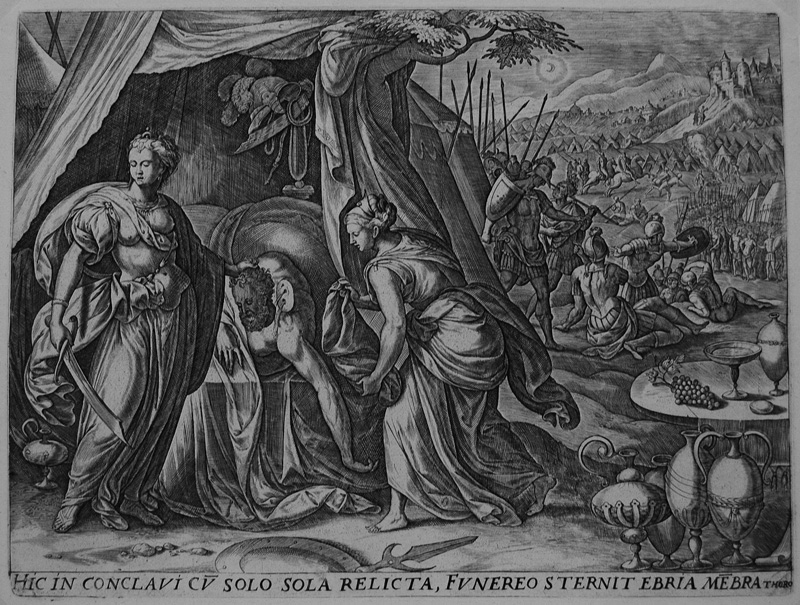 |
|
|
Maarten de Vos (Dutch, 1531-1603), after, Judith with the head of Holofernes (New Holl. 174 ii/iii). Original engraving after a drawing by de Vos. , c. 1585. From the Story of Judith (4 plates first published thus in 1585). In the first state (1579, after Jan Snellinck, the group with Judith's head is in profilefacing right; in the second state, probably after a drawing by De Vos, they appear as above. A rich impression on laid paper before the addition of "Iudith c.13.v.9" bottom right and the addition of the number "3" far right in the printing of the 1639 edition of the Theatrum Biblicum republished by Nicolaes Jansz. Visscher (c. 1587-1660) in 1643 and after Visscher's death in 1660. Image size: 205x257mm. Price: Please call or email for current pricing information.
|
|
|
|
|
|
|
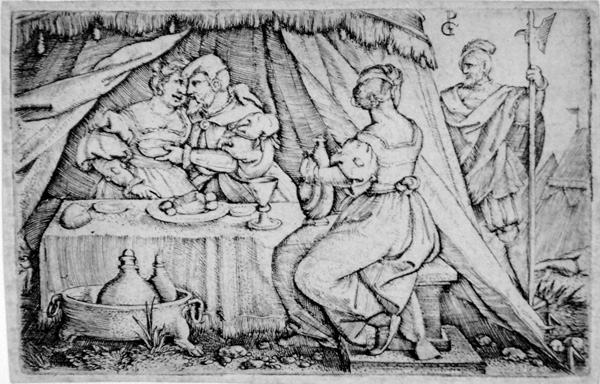 |
|
Georg Pencz (German, 1500-1550), Judith dining with Holofernes (Bartsch 24, only state). Original engraving, c. 1535, from Stories from the Old Testament. A good impression with thread margins on all sides. Signed with the monogram upper right between the guard and the right edge of the tent. Image size: 43x78mm. Price: Please call or email for current pricing information.
|
|
|
|
|
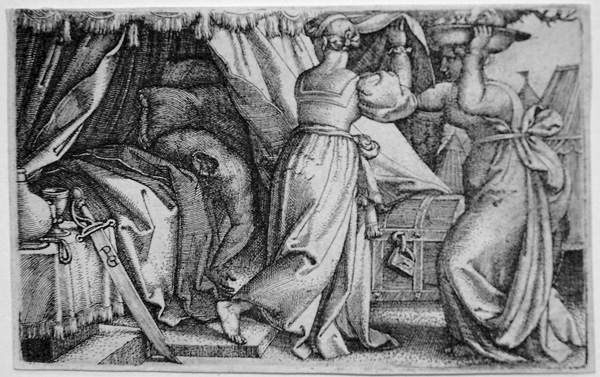 |
|
Georg Pencz (German, 1500-1550), Judith and her servant with the head of Holofernes (Bartsch 25, only state). Original engraving, c. 1535, from Stories from the Old Testament. A very good impression with thread margins on the bottom and the sides and cut on or within the plate mark on the top. Signed on Holofernes' sword with Pencz's monogram. Image size: 43x78mm. Price: Please call or email for current pricing information.
|
|
|
|
|
|
|
|
|
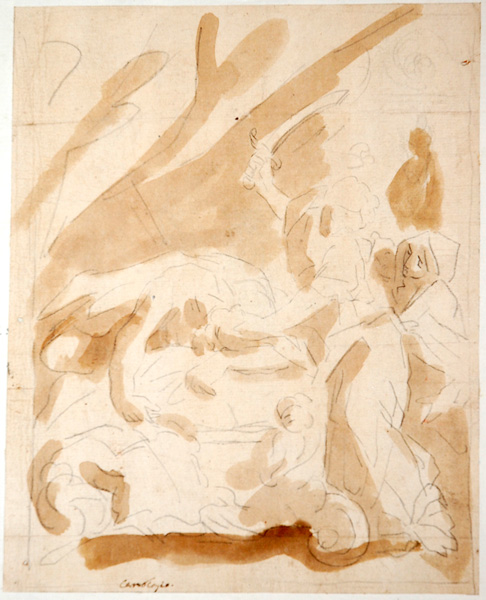 |
|
Luca Cambiaso (Genoa, 1527-1585, El Escorial, Madrid), attributed to, Judith beheading Holofernes. Pen and brown ink and wash and pencil. A quick sketch on cream laid paper mounted on laid paper. Attributed to Cambiaso in brown ink left-center at the bottom of the sheet. Trained by his father, Cambiaso soon became the leading painter in Genoa in the 16th century. A master of a quick spontaneous drawing style, Cambiaso produced many "ebullient and energetic drawings." Image size: 225x180mm. Price: Please call or email for current pricing information.
|
|
|
|
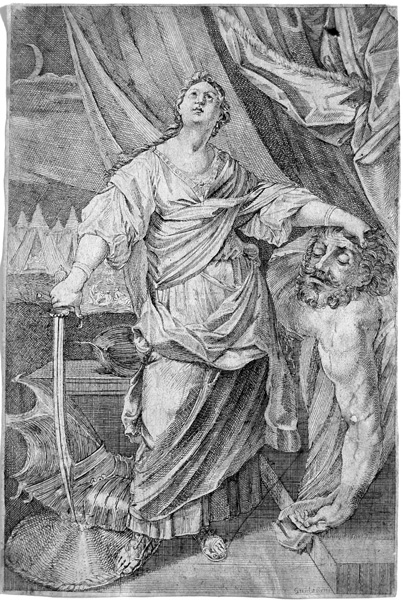 |
|
Guido Reni (Bologna, 1575-1642), attributed to, Judith with the head of Holofernes (not in Bartsch). Guido Reni was the most important Bolognese painter after the Carracci and Domenichino left for Rome. A beautiful etching on laid paper inscibed "Guido Reni" in the plate lower right. Stains in Judith's left arm and in the lower left. Small repaired tear in Holofernes' arm. Trimmed on or within platemark. Exhibited at the Chelsea Art Museum 12/10/2008-2/7/09 in "ItaliaArabia: Artistic Convergences between Italy and Egypt, Lebanon, Syria, and Iran" as by Guido Reni. Image size: 276x181mm. Price: Please call or email for current pricing information.
|
|
|
|
|
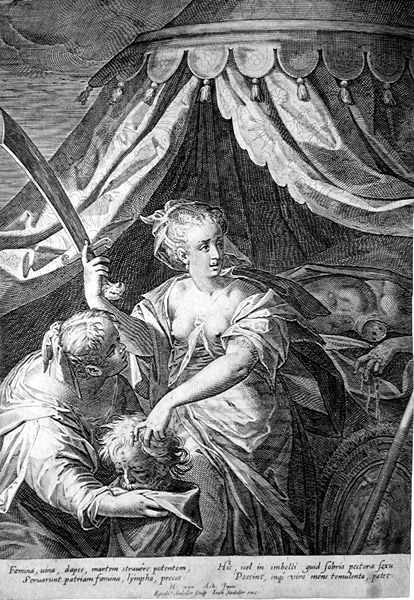 |
|
Aegidius Sadeler (Netherlandish, c. 1570-1629), Judith and Her Servant with Holofernes' head (New Holl, van Aachen 1). Engraving after Hans van Aachen, c. 1590. Printed on laid paper cut inside platemark. Small tear into right edge just above the center, minor creasing lower right corner, light stain in area of inscription. Van Aachen was one of Rudollf II's court painters in Prague; Sadeler became the Imperial Engraver and one of the great print artists of the time. Image size: 292x203mm. Price: Please call or email for current pricing information.
|
|
|
|
|
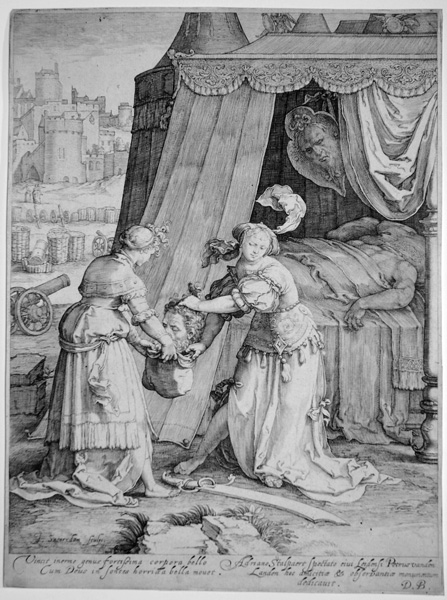 |
|
Jan Saenredam (Dutch, c. 1565-1607), Judith and the Head of Holofernes (B. 108 first state). Engraving after Lucas van Leyden, before 1598. Very good impression on laid paper. Signed in the plate lower left . A good impression on laid paper with thread margins. Goltzius sparked a revival of Lucas van Leyden. Saenredam was one of Goltzius' most important masters and worked closely with him, creating a major body of work. in the Dutch Mannerist tradition. Image size: 263x207mm. Price: Please call or email for current pricing information.
|
|
|
|
|
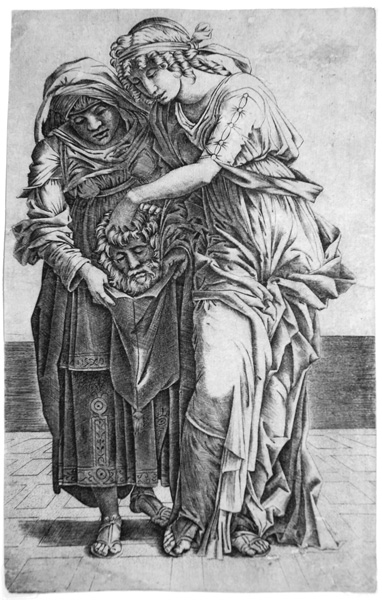 |
|
Raimondi School (Italian, fl. 1525-50), Judith and Her Servant with Holofernes' head (Bartsch 9). Engraving, c. 1520. This rare print reproduces an earlier engraving c. 1500-1505 by Girolamo Mocetti (Italian, 1470-1531), which in turn ultimately descends from Andrea Mantegna's engraving. A very good impression trimmed in the blank space at the top and within the platemark on the other three sides. Judith here can be seen both as virtue defeating vice and as civic heroism in the face of overwhelming odds. Image size: 194x123mm. Price: Please call or email for current pricing information.
|
|
|
|
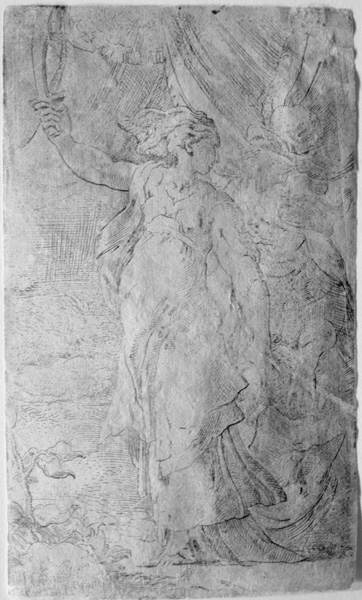 |
|
Parmigianino, Judith (Bartsch 1). Original etching, c. 1530. A fine but light impression of this delicate print on laid paper. According to David Ekserdjian's essay on Parmigianino's drawings and prints, Parmigianino is the "de facto father of Italian etching" ((Ekserdjian, in Franklin, p. 42). Thread margins or trimmed on the plate mark; several very short repaired edge tears. Illustrated in Eva/Ave: Images of Women in Renaissance Prints (National Gallery of Art, 1990), plate 22. There is a preparatory drawing for this etching in the British Museum (illustrated in Popham, plate XXXIX). Parmigianino was one of the most important of the first generation of Italian Mannerists. He influenced several generations of successors. Parmigianino only executed 15 etchings. Rare! Image size: 156x90mm. Price: Please call or email for current pricing information.
|
|
|
|
|
|
|
|
|
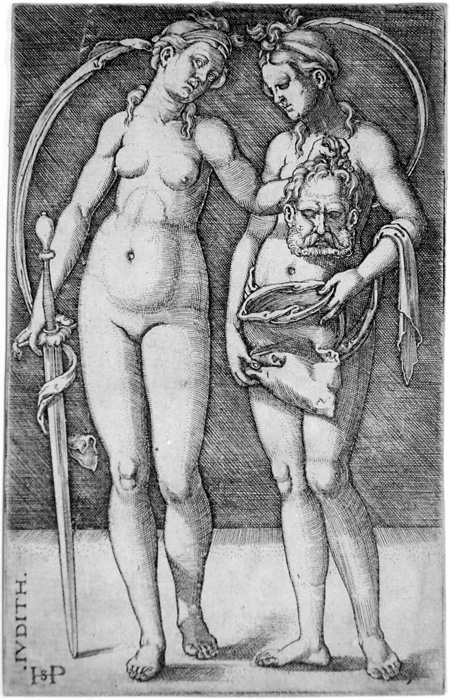 |
|
|
Hans Sebald Beham (German, 1500-1550), Judith and Her Servant Standing (Bartsch. 10, Pauli 11). Original engraving, c. 1531. A very good early 16th-century impression with inky plate edges and thread margins. Rare in this condition. Illustrated in Eva / Ave: Women in Renaissance and Baroque Prints (National Gallery of Art, 1990), plate 25. Image size: 108x69mm. Price: Please call or email for current pricing information.
|
|
|
|
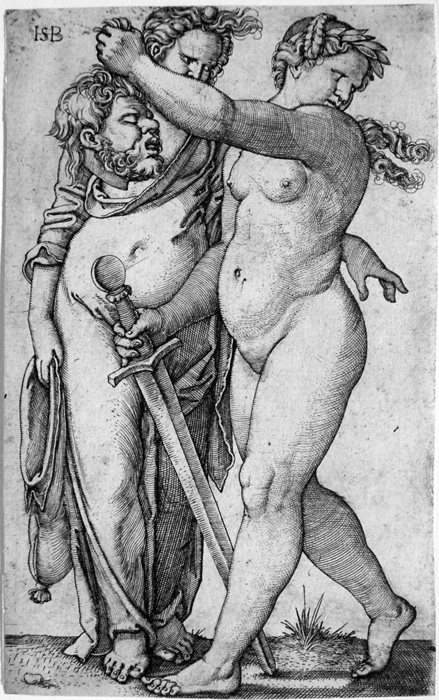 |
|
Hans Sebald Beham (German, 1500-1550), Judith and Her Servant Walking to the left (B. 11, P. 12,). Original engraving, c. 1531. A very good early impression with good plate tone of this scarce print on laid paper. Very rare. Trimmed on or within the platemark. Illustrated in Eva/Ave: Images of Women in Renaissance Prints (National Gallery of Art, 1990), plate 26. A surprisingly monumental print packed into a fairly small space! Image size: 115x73mm. Price: Please call or email for current pricing information.
|
|
|
|
|
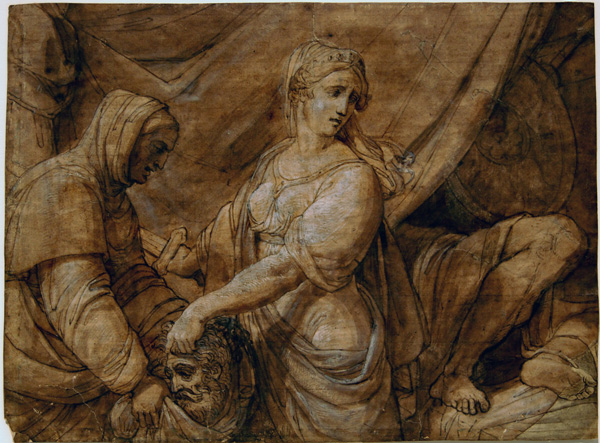 |
|
|
|
Giulio Romano (Giulio Pippi; Rome 1499-1546 Mantua), after, Judith and her servant with the head of Holofernes. Pen and brown ink, heightened with white wash on cream laid paper. Later 16th century. Giulio Romano, Raphael's chief assistant, succeeded him after Raphael's death. After the Sack of of Rome, he completed Raphael's unfinished projects, including the Sala di Costantino in the Vatican, and went to Mantua, where he spent most of the the rest of his life working on projects for the Duke of Mantua, Federico II Gonzaga, most notably the Palazzo del Té, for which he was architect, designer of its program of paintings, and chief painter. Image size: 262x363mm. Price: SOLD.
|
|
|
|
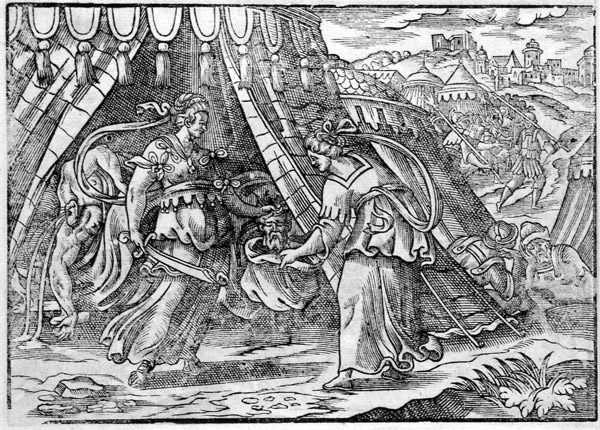 |
|
|
Jean Cousin the Younger (French, 1522-1594), Bethulie delivered by Judith's heroic spirit. Original woodcut, c. 1590-1594. Published in Figures de la Sainct Bible (1596, 1614). Jean Cousin and his father were both court painters for the Valois kings. These woodcuts are strongly mannerist in style. On the verso is "Le jeune Tobie espose Sara, & rend la vue à son pere." Image size: 136x191mm. Price: Please call or email for current pricing information.
|
|
|
 |
|
|
|
Hans (Jan) Collaert (Antwerp, 1566-1628), Judith (New Holl. de Vos 239 ii/ii). Engraving after Marten de Vos. Plate 17 from a set of "Celebrated Women of the Old Testament" consisting of twenty engravings (plus frontispiece) by Hans Collaert, Adrien Collaert, and Carel van Mallery published in Antwerp by Phillip Galle (1537-1612). Image size: 154x88mm. Price: Please call or email for current pricing information.
|
|
|
|
|
|
|
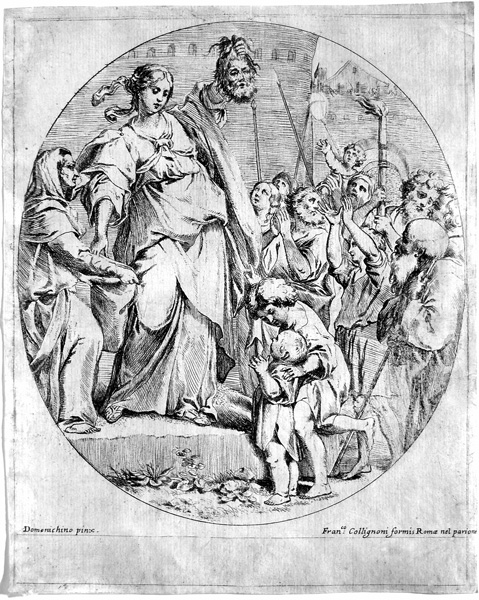 |
|
|
Domenichino (1581-1641), after, Judith showing the Israelites Holofernes' head. Etching, c. 1630-50. From 1603 to 1610, Domenichino was a part of Annibale Carracci's workshop and worked on Annibale's various projects for the Farnese family, taking a more active leadership role as Annibale's physical and mental health declined. From 1609 to 1615 he was engaged in a series of major projects in Rome, including The Last Communion of St Jerome (Rome, Musei Vaticani) and the cycle of frescoes in the Polet Chapel of San Luigi dei Francesi, From 1617 to 1621 he worked in Bologna and elsewhere in Emilia and Romagna before his appointment by Pope Gregory XV as papal architect. For the next ten years, he had a series of major commissions before leaving Rome in 1631 for Naples where he painted a series of frescoes and altarpieces in the Capella del Tesoro de San Gennaro. This etching was made by Francois Collignon, a French artist working in Rome c. 1630-1650. Ours is a good impression on laid paper with thread margins. Signed in the plate with the names of Domenichino and Collignon. Image size: 194x123mm. Price: Please call or email for current pricing information.
|
|
|
|
|
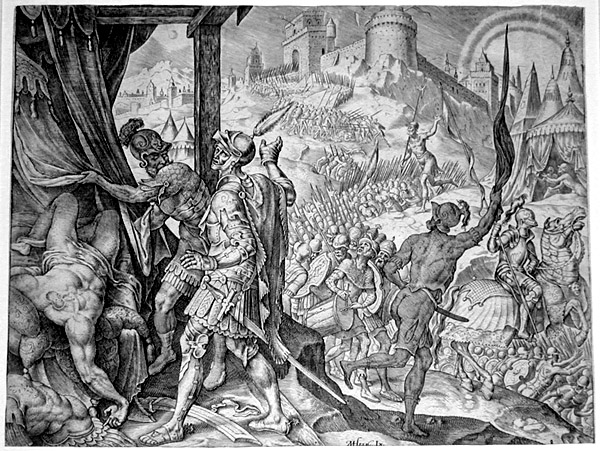 |
|
|
Philips Galle (Antwerp, 1537-1612), The discovery of the headless body of Holofernes (TIB 5601.016:8). Engraving after Maerten van Heemskerck, c. 1565. Plate 8 from a set of The Story of Judith and Holofernes consisting of eight engravings. Image size: 204x248mm. Price: Please call or email for current pricing information.
|
|
|
|
|
Spaightwood Galleries, Inc.
To purchase, call us at 1-800-809-3343 (1-508-529-2511 in Upton MA & vicinity) or send an email to spaightwood@gmail.com.
We accept AmericanExpress, DiscoverCard, MasterCard, and Visa.
We also accept wire transfers and paypal.
For directions and visiting information, please call. We are, of course, always available over the web and by telephone (see above for contact information). Click the following for links to past shows and artists. For a visual tour of the gallery, please click here. For information about Andy Weiner and Sonja Hansard-Weiner, please click here. For a list of special offers currently available, see Specials.
All works are sold with an unconditional guarantee of authenticity (as described in our website listing).
Go back to the top of this page.
Visiting hours: Saturday 10:00 am to 5:00 pm and Sunday noon to 6:00 pm and other times by arrangement.
Please call to confirm your visit. Browsers and guests are welcome.
|
|
|
|
|
|
|
|
|
|
|
|
|
|
|
|
|
|
|
|
|
|
|
|
|
|
|
|
|
|
|
|
|
|
|
|
|
|
|
|
|
|
|
|
|
|
















